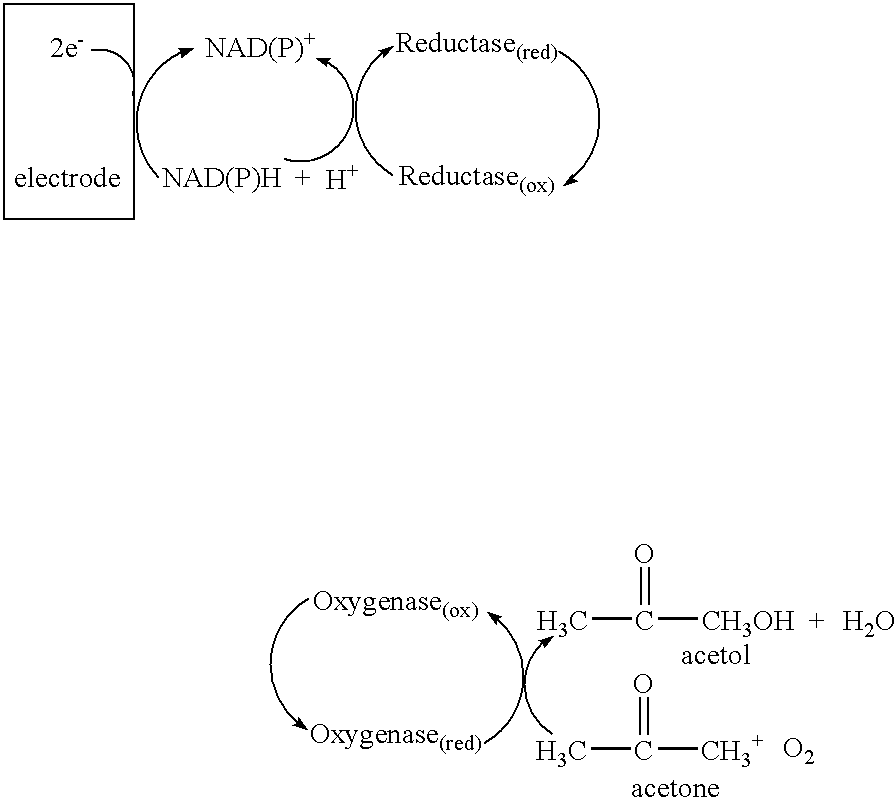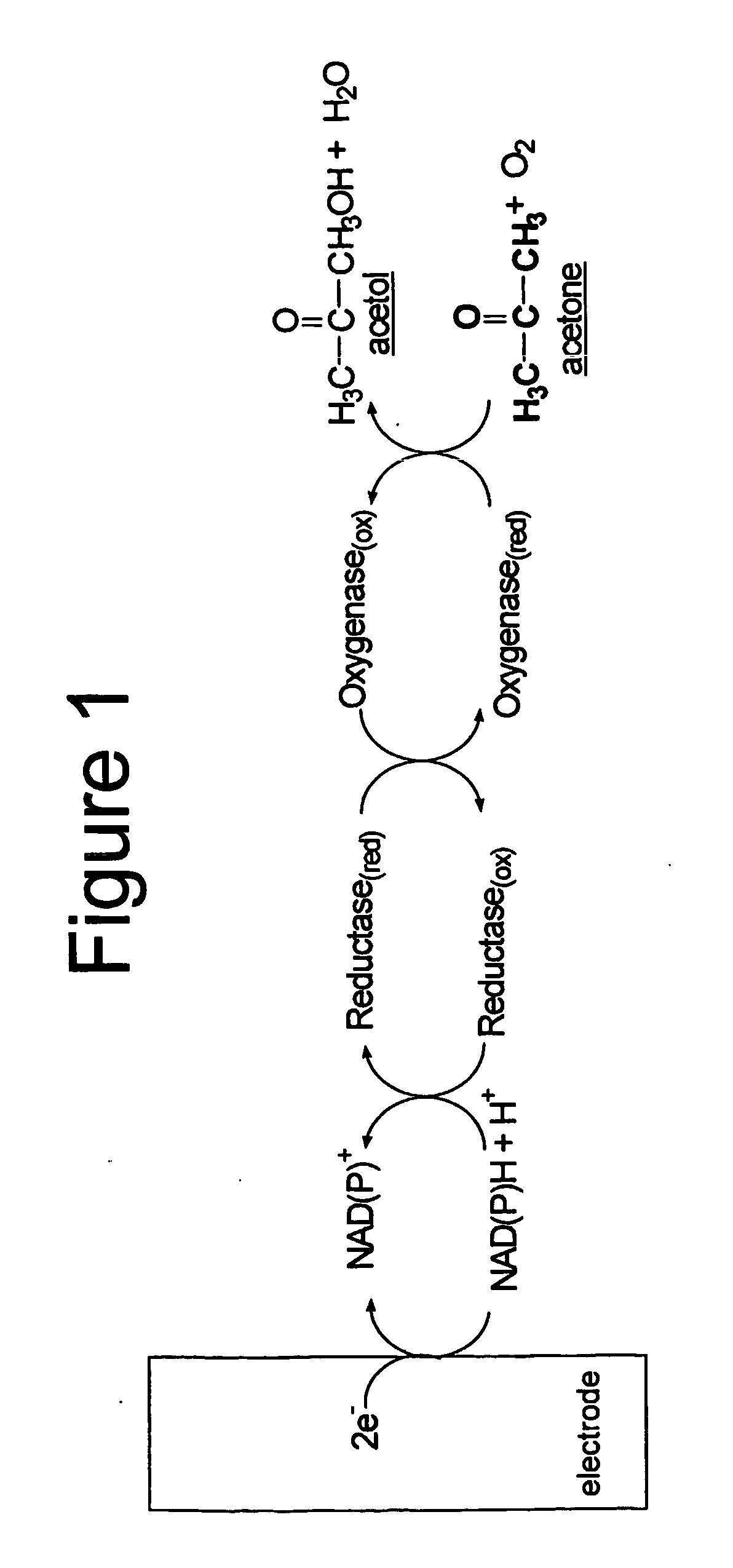Enzyme-based system and sensor for measuring acetone
a technology of acetone and enzymes, applied in the field of acetone detection, can solve the problems of inability to conduct regular subject self-monitoring, and the general availability of acetone-specific detection technologies outside the laboratory or clinic setting, and achieve the effect of low cost and convenient transportation
- Summary
- Abstract
- Description
- Claims
- Application Information
AI Technical Summary
Benefits of technology
Problems solved by technology
Method used
Image
Examples
example 1
Acetone Carboxylase Coupled to NADH Oxidation Spectrophotometric Assay.
[0176] Assays were performed in 2 mL (1 cm path length) quartz cuvettes that had been modified by fusing a serum bottle-style quartz top (7×13 mm at mouth), allowing the cuvettes to be sealed with a red rubber serum stopper. The reaction mix contained ATP (10 mM), MgCl2 (11 mM), potassium acetate (80 mM), MOPS (100 MM), CO2 (50 mM (1 mol CO2(g) to 4 mol potassium bicarbonate to maintain pH)), and 20 to 40 μg purified acetone carboxylase in a total volume of 1 mL at pH 7.6. The addition of P-hydroxybutyrate dehydrogenase (3 U) and NADH (0.2 mM) allowed acetoacetate formation to be coupled to the oxidation of NADH. Assays were pre-incubated for 2 min. at 30° C. with all assay components except acetone. Assays were initiated by addition of acetone (2 mM). The reaction was monitored by measuring the decrease in absorbance at 340 nm (ε340 of 6.22 mM−1·cm−1 for NADH) over time in an Agilent Technologies (Palo Alto, C...
example 2
Secondary Alcohol Dehydrogenase NADH Oxidation Spectrophotometric Assay.
[0178] Assays were performed in 2 mL quartz cuvettes and contained NAD(H) (0.2 mM), potassium phosphate buffer (25 mM), and a source of enzyme (cell-free extracts, column fractions, or purified enzyme) in a total reaction volume of 1 mL at pH 6.2 (for ketone reduction assays) or pH 7.8 (for alcohol oxidation assays) at 30° C. Assays were pre-incubated for 1.5 min. at 30° C. with all assay components except substrate. Assays were initiated by addition of substrate (2.5 mM) and monitored over time by measuring the change in absorbance at 340 nm (ε340 of 6.22 mM−1·cm−1 for NADH).
Secondary Alcohol Dehydrogenase Coupled to H2O2 Formation Spectrophotometric Assay.
[0179] Assays were performed in 2 mL (1 cm path length) quartz cuvettes and contained potassium phosphate (50 mM), 1.5 μg purified S-ADH, NADH (50 μM), lactate (10 mM), lactate dehydrogenase (20 U), pyruvate oxidase (2 U), peroxidase (15 U), flavin adeni...
example 3
Initial Electrochemical Measurement of NADH and Correlation to Spectrophotometric Data.
[0192] 10 micron disc carbon fiber microelectrodes were purchased (from Bioanalytical Systems (“BAS”), West Lafayette, Ind. (part number MF-2007)) and pretreated using the method of Kuhr et. al. (63). The electrode surface was polished for 10 min. with 1 μm diamond paste (Bioanalytical Systems) and sonicated in hot toluene for 2 min. To remove residual polishing material, the microelectrode was rinsed once in methanol and once in water, then sonicated twice in water for 1 min. The polished microelectrode was subsequently pretreated electrochemically in 1 M HCl by twice applying 10 cycles of 100 V / s from −200 mV to +1800 mV. Then the microelectrode was treated in 100 mM potassium phosphate buffer by twice applying 10 cycles of 0 to +1200 mV at 100 mV / s. Background scans were then obtained from phosphate buffer alone. All potentials were referenced versus a Ag / AgCl reference electrode (Bioanalytic...
PUM
| Property | Measurement | Unit |
|---|---|---|
| pH | aaaaa | aaaaa |
| molecular mass | aaaaa | aaaaa |
| angle | aaaaa | aaaaa |
Abstract
Description
Claims
Application Information
 Login to View More
Login to View More - R&D
- Intellectual Property
- Life Sciences
- Materials
- Tech Scout
- Unparalleled Data Quality
- Higher Quality Content
- 60% Fewer Hallucinations
Browse by: Latest US Patents, China's latest patents, Technical Efficacy Thesaurus, Application Domain, Technology Topic, Popular Technical Reports.
© 2025 PatSnap. All rights reserved.Legal|Privacy policy|Modern Slavery Act Transparency Statement|Sitemap|About US| Contact US: help@patsnap.com



